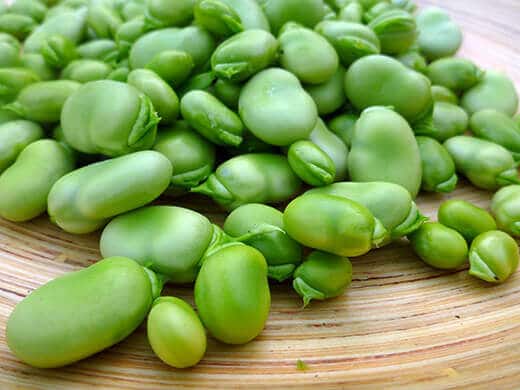About
"If all you know about fava beans is that Hannibal Lecter favored them with a nice Chianti, it’s time to get better acquainted (with favas, that is). They're an ancient member of the pea family and have a nutty taste and buttery texture all their own." [source] A sweet treat, fava beans often carry a bad reputation because many American recipes require extra peeling that can make it can be hard to prepare them. But never fear! Favas are a delicious staple of many Mediterranean and Middle Eastern cuisines, and there are many different, enticing ways to prepare them."Fava beans are a staple of Mediterranean and Middle Eastern cooking. Young favas can be used unpeeled, but as they mature, their tough outer skins need to be removed. It's well worth the effort—their rich flavor is wonderful in everything from light salads to hearty stews." [source]
Health Benefits
Fava beans are high in vitamins A and C, as well as calcium.
"Fava beans, also widely known as broad beans, come in soft green pods that yield tender, sweet, spring-y beans perfect in salads and other spring-time dishes." [source]Storage
Store fava beans in the refrigerator in a tightly sealed plastic bag. They should last 2-3 weeks, but are best enjoyed within a week.
"Under the British name, broad beans, this springtime crop was common in colonial American kitchen gardens. It's not quite clear when or why we forgot about them, but in Tuscany, where I now live, favas are snatched up as soon as they appear, to be shelled at the table and eaten raw with young pecorino." [source]Preparation
Many recipes found in America call for fava beans that have been taken out of both the pod and the white outer shell that surrounds each individual bean. This is not always necessary, however! Many of the traditional Mediterranean and Middle Eastern recipes call for fava beans still in their shells, and sometimes even still in the pod! [source]
To take the beans out of the pod, split the pod lengthwise like you would a pea pod or a green bean. If you are not taking off the shells, the beans are ready to use and eat at this point.
If you are going to peel off the shells, there are two common methods you could use - it can sometimes be a little bit tricky (which gives fava bean the bad rep they don't deserve!). The first is to use a knife to cut through each bean shell [source].You can also blanch them, and then squeeze the beans from the peels, as Martha Stewart explains in this video.
Recipes:
- Roman style: eat them raw with some fresh pecorino or sheep's milk feta cheese [source]
- Raw or cooked in salads
- Grilled!
- Puréed into soups (this one too)...
- ... or just as a purée of their own
- Added to any veggie sautée
- The Saveur Recipe List
- The Martha Stewart Produce Guide Recipe List
- The All About Fava Beans Recipe List
Do you have a fava bean recipe you love? Send it to us! Email us at info@brownmarketshares.com and let us know what you did with your favas (and the rest of your share) this week.






0 comments:
Post a Comment